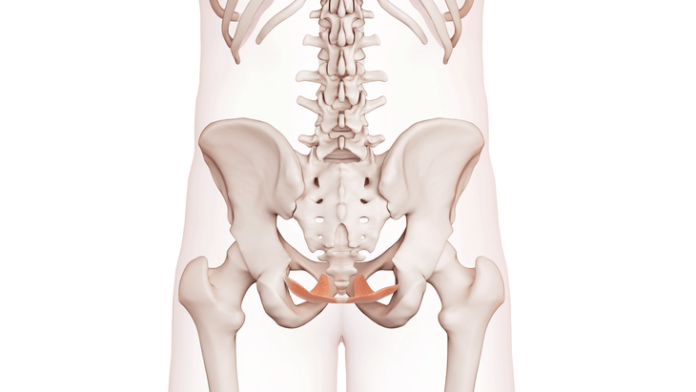“], “filter”: { “nextExceptions”: “img, blockquote, div”, “nextContainsExceptions”: “img, blockquote, a.btn, a.o-button”} }”>
Heading out the door? Read this article on the new Outside+ app available now on iOS devices for members!
>”,”name”:”in-content-cta”,”type”:”link”}}”>Download the app.
The trickle. It’s an all-too-common experience among runners and other athletes, especially females. As a personal trainer and running coach, I’m often a sounding board for those who experience the confusion, frustration, and shame that accompany stress incontinence.
To avoid the potential embarrassment of exercise-induced bladder leakage, many athletes no longer attend group runs or exercise classes. But there’s a less isolating option. Although yoga can’t necessarily cure stress incontinence, it can strengthen the pelvic floor muscles and potentially reduce the occurrence of leakage and ensure that you can run (or hike or climb or jump or squat or lift weights or play pickleball) with a lot less fear.
What Is Stress Incontinence?
There’s a difference between urinary incontinence and stress incontinence. Urinary incontinence is a loss of bladder control from any cause, including medications, infections, and illness. Stress incontinence, sometimes referred to as stress urinary incontinence (SUI), refers specifically to urine leakage that occurs during movement or activity of any sort. In the absence of activity, those with stress incontinence maintain bladder control.
Although stress incontinence can feel like it’s a problem that only you experience, research suggests that more than 40 percent of females have experienced urinary incontinence during exercise. Less research has been conducted on males, but surveys suggest less than 10 percent of that population are affected.
Stress incontinence can happen at any age. It’s caused by either weakened or overly tight pelvic floor muscles, which are a group of often-overlooked muscles arranged across the pelvic bones in a hammock-like fashion. They form the base of the core muscles, span from the diaphragm to the pelvic floor, and encircle the trunk in a 360-degree manner.
These muscles support the bladder, bowels, and, for many of us, the uterus. As such, they control the flow of urine and the excretion of feces and gas. The pelvic floor muscles also help support your breath and posture.
Pelvic floor muscles respond to any changes in pressure in the abdominal cavity. When we inhale, the belly fills with incoming breath. This increased intrabdominal pressure stretches the pelvic floor muscles. When we exhale, the diaphragm contracts to help expel air. This allows the pelvic floor muscles to contract.
How Does Exercise Cause Stress Incontinence?
With stress incontinence, movement places pressure on the bladder or causes the pelvic floor muscles to relax. Either can lead to leakage. Some common activities that trigger stress incontinence include:
- Running
- Jumping
- Playing pickleball, tennis, or engaging in other quick movements
- Soccer and kickboxing
- Lifting heavy weights
- Squatting
- Bending over
- Crunching or other abdominal exercises
- Laughing
- Coughing
- Sneezing
However, each person’s situation is different. Before self-diagnosing yourself with stress incontinence, it’s best to consult with a pelvic floor physical therapist or a physician if you have questions or suspect you may experience this condition.
Some of the most common causes of stress incontinence for females include:
- Pregnancy: The release of hormones and the weight of the uterus during pregnancy can overstretch and weaken the pelvic floor.
- Childbirth: Vaginal delivery increases the risk of pelvic floor dysfunction because the muscles often become significantly stretched or experience other trauma and injury during delivery.
- Menopause: As hormone levels drop, pelvic floor muscles can become weaker and less responsive to voluntary control.
- Imbalances in the core muscles: If you do a lot of Pilates, yoga, or other core exercises for the abdominal muscles but do not also strengthen the pelvic floor muscles, the compression from strong abs can place too much pressure on weak pelvic floor muscles.
- Overly tight pelvic floor muscles. When the pelvic floor muscles are chronically tight, there can be excessive pressure or contraction around the urethra. Likewise, overly tight muscles can restrict range of motion which, in turn, limits efficient muscle contraction and urine control.
For males, additional research is needed, although recent studies suggest the causes include:
• Prostate surgery: Research suggests the likelihood of stress incontinence increases after prostate surgery.
• Chronice coughing: Stress incontince can also accompany conditions that cause chronic coughing, such as asthma and emphysema.
• Studies also suggest that yoga can help males with urogenital problems and may even improve sexual performance.
5 Yoga Poses That Help With Stress Incontinence
Learning to engage the pelvic floor muscles is part of the equation. You want to not only contract and strenghten your pelvic floor muscles, but also relax them as fully as possible. The following yoga poses can help bring more intentionality and awareness to the contraction and relaxation of the pelvic floor.
Mindful breathing—a core tenet of yoga—can also help restore optimal health and flexibility. Working with your breath throughout the poses by slowing your inhalations and lengthening your exhalations can help the muscles fully engage and relax.
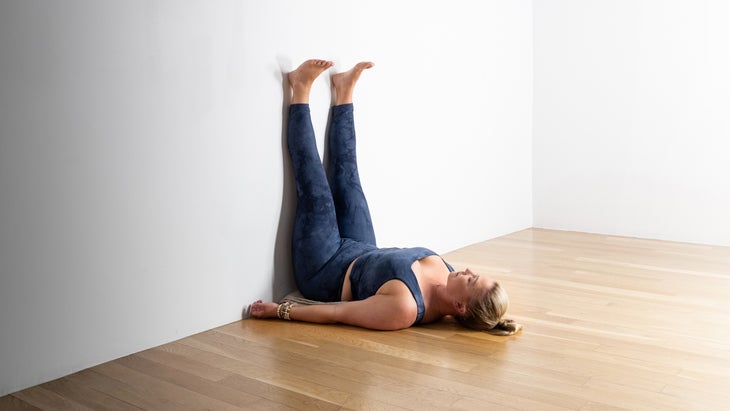
1. Legs Up the Wall (Viparita Karani)
Legs up the Wall removes pressure on the diaphragm and abdomen and allows you to experience deep, slow, rhythmic breathing, both of which relax the pelvic muscles. The pose is also an effective stretch for the hamstrings, which can be notoriously tight in runners.
You can rest here or practice Kegel exercises by alternating contraction of the pelvic floor muscles with complete relaxation. The lack of tension in your other core muscles allows you to isolate and better connect with the pelvic floor muscles.
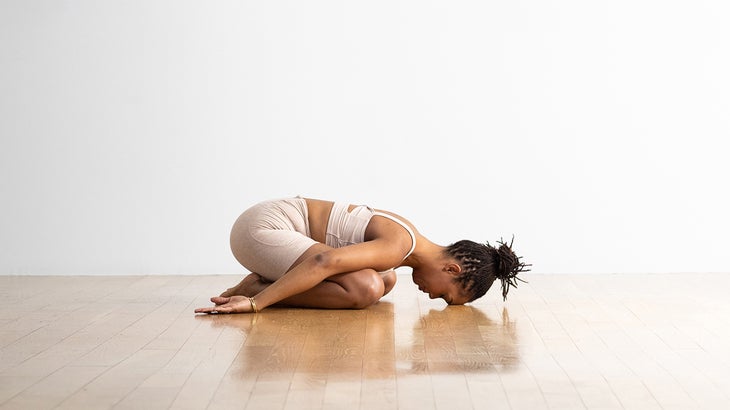
2. Child’s Pose (Balasana)
Aside from stretching the glutes, spine, upper back, and shoulders, Child’s Pose can improve the flexibility of your pelvic floor muscles. As you stretch your lower back with each inhalation in Child’s Pose, the pelvic floor girdle expands. This helps elongate the muscles and release tension. This restorative pose may seem like little more than a way to relax, but it’s profoundly beneficial for stress incontinence.
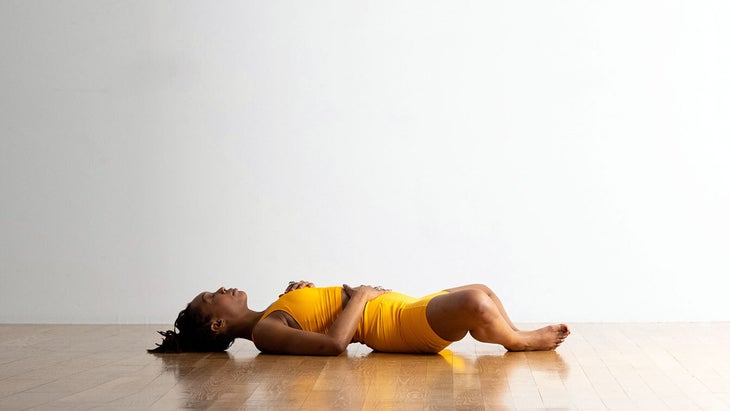
3. Reclined Bound Angle (Supta Badha Konasana)
This pose stretches the inner thigh muscles, known as the adductors, which are stronger and more dominant muscles than pelvic floor muscles. When the adductors are tight, they tug on the pelvic floor muscles, making activating and contracting the latter difficult. In turn, this can increase the risk of stress incontinence. Practice Reclined Bound Angle for a few minutes after your cool down or even in bed before falling asleep.
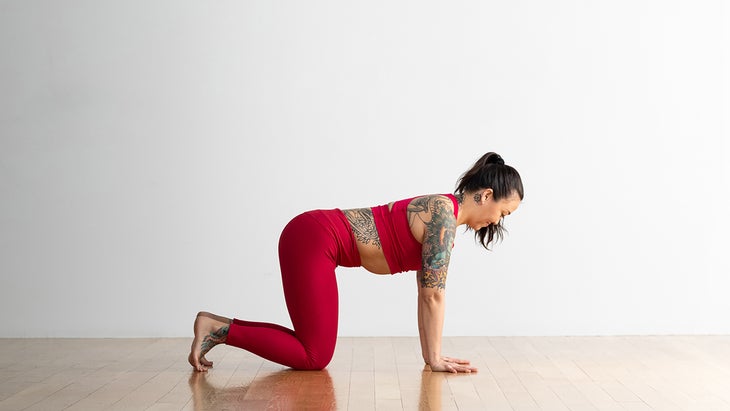
4. Tabletop
This simple pose consists of being on your hands and knees with your hips stacked over your knees and your shoulders over your wrists. As you contract your core muscles to prevent your lower back from sagging, you also engage the pelvic floor muscles in an isometric contraction, which can make you more subtly aware of these less commonly used muscles. Tabletop also lightly stretches the pelvic floor region, which can reduce pressure on the bladder and bowels.
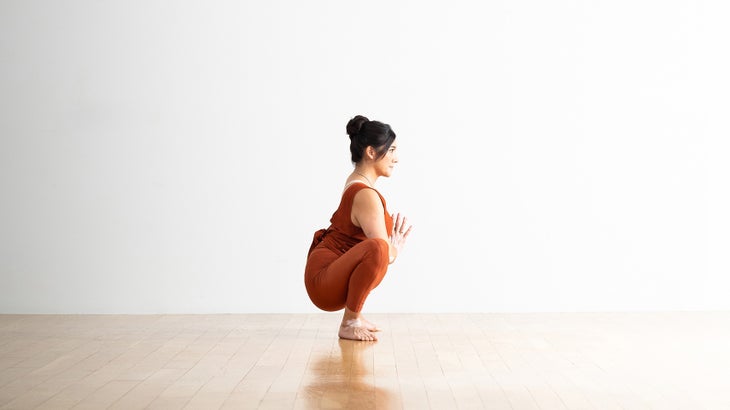
5. Squat (Malasana)
Many athletes experience stress incontinence in this exercise. The intense focus on contracting the abdominal and leg muscles can allow the pelvic floor muscles to relax, resulting in leakage.
But proper engagement of your core during a squat also strengthens pelvic floor muscles. When you learn to activate your pelvic floor muscles in this pose, you train your body to do the same when squatting in other exercises and activities.
Squat Pose also strengthens most of the major muscles in the lower body and core, an added bonus for athletes whether or not they suffer stress incontinence.


